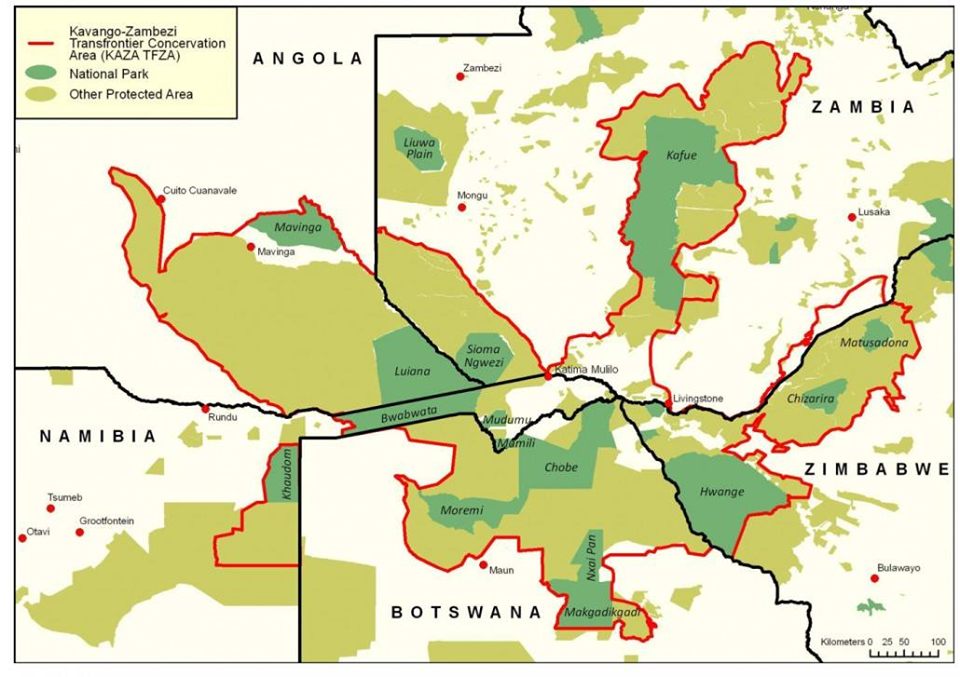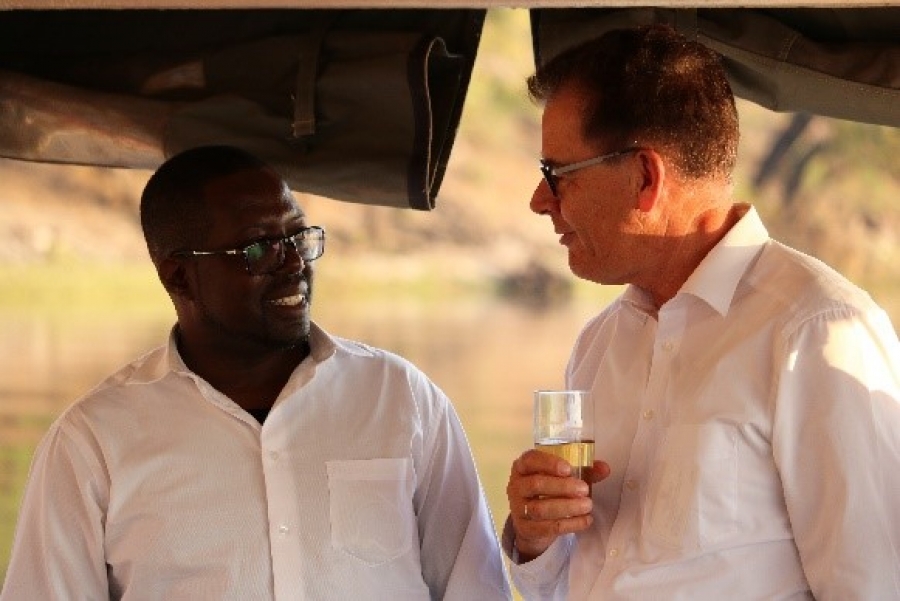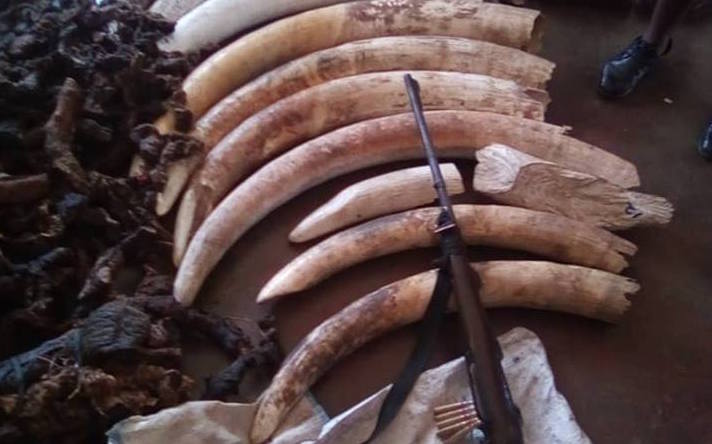14 Dec. 2018
Six years and €50-million since its creation, Oscar Nkala visits the Kavango Zambezi Transfrontier Conservation Area to find out what impact it has had on wildlife and communities.

Tourist attraction: One of KAZA’s aims is to promote cross-border movement of endangered species, including wild dogs. Photo: KAZA
The world’s largest international conservation and eco-tourism zone was signed into being with a treaty between five Southern African governments – Angola, Botswana, Namibia, Zambia and Zimbabwe – on March 15 2012.
The treaty sealed what began in August 2011 as a memorandum of understanding to develop Southern Africa’s largest transfrontier conservation area, with the objective of promoting regional conservation and cross-border movement of migratory game species, especially elephants.
With an estimated surface area of 109-million acres covering 36 private and state-owned game reserves in five countries, the Kavango Zambezi (KAZA) Transfrontier Conservation Area is home to numerous tourist attractions, more than 3,000 plant and bird species in addition to big and small game.
An estimated 1.5-million people live around KAZA game parks and forest areas, sharing water and forest resources with up to 44% of Africa’s remaining elephants. The KAZA land-mass distribution is 17% in Angola, 30% in Botswana, 14% in Namibia, 25% in Zambia and 14% in Zimbabwe.
From Kasane in Botswana, a secretariat implements KAZA’s objectives of conservation of shared natural resources, promoting and facilitating “the development of a complementary and linked network of protected areas to protect wildlife, and to provide and restore dispersal corridors and migratory routes”.
The secretariat also seeks to “implement programmes that ensure the sustainable use of natural resources in ways that improve the livelihoods of the communities, and reduce poverty in the region”.

Elephant corridor: In the Okavango Panhandle area, elephant conservation group Eco-exist is engaged in mitigating human-elephant conflict. Photo supplied
Human-animal conflict
Six years and €50-million in German funding later, Oxpeckers visited KAZA to find out what impact it has had on wildlife and communities in the Kavango-Zambezi river basins.
In the Cross Dete communal area adjacent to Hwange National Park, Zimbabwe’s flagship component of KAZA, Oxpeckers met villagers who did not even know they are stakeholders in the world’s largest conservation area.
“We have never heard of KAZA. It has no wildlife management or community development projects here, although the human-animal conflict is at its worst. Lions eat our livestock daily, and elephants destroy the fields year in and year out,” said Prince Sansole, a local conservation activist.
“We don’t grow crops anymore to avoid losing them to elephants. We want to co-exist with wildlife, as we have done for years, but why don’t we get the benefits of suffering the consequences of hosting the wild animals?”
Councillor Zamani Kalimbota, who joined the Hwange Rural District Council as representative of the political ward adjacent to Hwange National Park in 2008, said he handles numerous cases of human-wildlife conflict daily.
“The conflict is worse now than it was ever before, but the only help we have received was from the problem animal component (PAC) of the local government council.
“We have no PAC or wildlife-based community development projects funded by KAZA and local partners. Even the Zimbabwe Parks and Wildlife Management Authority is not helping with the wildlife conflict. We live in an endless state of war between the people and the animals,” he said.

KAZA has an estimated surface area of 109-million acres and expands across 36 private and state-owned game reserves in five countries
Political relations
In Victoria Falls, Oxpeckers met a senior ZimParks officer involved in coordinating cross-border anti-poaching operations in the Zambezi and Matetsi national parks. He said besides tourism, which uses the KAZA uni-visa to share tourists with Zambia and Botswana, no other sector has benefited from the transfrontier conservation area (TFCA).
“In KAZA Zimbabwe, not much has been done because the TFCA was launched at the height of the economic and political crises, which strained relations with the world and neighbours like Botswana, the lead implementing country for KAZA.
“Despite public expressions of support, privately our neighbours were unhappy because we had no financial capacity, and lacked the political will to implement agreements as signed. When other members began implementing their KAZA plans, we just stalled. Even today we have excellent plans on paper, but still no capacity to implement them,” the officer said. He asked not to be named.
At one time, political relations were so strained that Botswana and Zambia wanted Zimbabwe out of joint projects like KAZA and the Kazungula Bridge due to concerns that its political and economic stigmas would stall regional development by scaring away potential donors and development partners.

Poaching problems: Rhino cow killed in Ghanzi, Botswana, in March 2018. The calf died a few days later beside the carcass of its slain mother. Nine rhinos have been killed by poachers in Botswana in 2018. Photo: Oscar Nkala
Cross-border poaching
In this part of the Zambezi Valley, cross-border poaching by Zambian gangs remains rife and because of policy differences between member states, there is little hope it will be resolved quickly.
“Cross-border poaching by Zambian gangs is a big problem in the Zambezi, Victoria Falls and Matetsi national parks. We are dealing with it, but not with the help of the KAZA TFCA. Botswana, Namibia and Angola are also under siege from poachers whose impunity is guaranteed back home.
“Because Zambian police do not cooperate in cross-border hot-pursuits, almost all poacher trails end on the Zambezi. KAZA was supposed to find political and security means to end cross-border poaching. It has failed, and that failure has emboldened the poachers,” said the ZimParks officer.
In the absence of a coordinated regional anti-poaching strategy, low-level intelligence sharing is helping Zimbabwe and Botswana deal with the Zambian poaching menace. Most Zambian poachers coming from Botswana have been killed or arrested in Zimbabwe as a result of intelligence supplied by Botswana Defence Force anti-poaching units.
Elephants Without Borders executive director Mike Chase said KAZA’s elephant migration and poaching problems have worsened. More elephants are taking up refuge in Botswana to escape the organised poaching syndicates operating in Zambia, Zimbabwe, Namibia and, of late, Angola.
“I cannot say whether KAZA has succeeded or not, but the concentration of elephants in Botswana suggests that the migration corridors to natural dispersal zones in Zimbabwe, Namibia, Zambia and Angola have ceased to exist. The causes are human encroachment and insecurity due to poaching.
“Elephant mortality is higher today in KAZA flagship game reserves of Luiana (Angola), Kwando (Namibia) and Sioma-Ngezi (Zambia). Up to nine organised Zambian poaching gangs operate in Botswana because this is where KAZA’s last remaining trophy-quality elephant bulls are,” he said.
Chase said the poaching scourge in KAZA has forced elephants to seek security by moving closer to human settlements, a trend which has magnified the human-elephant conflict. The conflict is now subject of a propaganda war, with pro-hunting groups using it to advance the theory of an elephant population explosion to justify calls for a lifting of the four-year-old trophy hunting ban in Botswana.

Funding support: KAZA executive director Dr Nyambe Nyambe (left) and German Minister of Economic Cooperation and Development Gerd Muller meet in Kasane, August 2018
‘Paper park’
Oxpeckers was unable to talk to KAZA executive director Dr Nyambe Nyambe. However, a senior secretariat officer who spoke on condition of anonymity said KAZA was being failed by political wrangling and different development priorities among member states.
“KAZA remains a giant paper park, and the biggest obstacle to its realisation is the lack of political will among member states. We have great plans, long approved by the governments and donors. But there is no implementation due to political interference, which is symptomatic of a fight for power, influence and control among member states.
“The political tussles have filtered into the boardrooms and offices, causing disharmony and killing consensus in project implementation. Representatives push competing political agendas that are dictated from their capitals, and they will sabotage what their political masters do not support,” he said.
He said further differences have arisen over the allocation of resources, with less-developed member states demanding more and pushing for decreased allocations for those considered more developed, specifically Botswana.
“The Secretariat employs technocrats, but they work under governments led by politicians. So politics influences decisions. For example, KAZA does not support human-wildlife conflict mitigation in Chobe National Park because Botswana is considered rich and capable of self-funding these initiatives.
“That is despite being home to the largest and most affected part of KAZA territory. Member states with far less animals and territory want more resources for projects that never materialise. Another problem is the lack of financial and project accountability, and the donors are part of it,” he said.

Flagship species: Elephant meat, a gun and ivory abandoned by suspected Zambian poachers after a gunfight with Zimbabwean game rangers in KAZA flagship, Hwange National Park, in September 2018. Photo: Bhejane Trust
Elephant management plans
Addressing a KAZA planning workshop held in Kasane in August, the Permanent Secretary in the Botswana Ministry of Environment, Natural Resources Conservation and Tourism, Thato Raphaka, said differing elephant management policies and inadequate transboundary coordination in fighting poaching and the illegal wildlife trade were major impediments to long-term implementation of KAZA-wide elephant management plans.
He said member states have a major responsibility to protect elephants, and it was critically important to determine how best to facilitate the re-opening of transboundary migration and dispersal routes. Raphaka said for the TFCA to work, member states should re-align existing legal, policy and management frameworks to focus on elephant conservation as the flagship species of KAZA.
Progress towards the realisation of KAZA was stalled due to insufficient community empowerment, which is characterised by limited benefits from wildlife, he said.
Insufficient project monitoring, the lack of “adaptive” rangeland management systems, lack of knowledge of ongoing and upcoming challenges in elephant habitat and the existence of critical gaps in the coordination of transboundary elephant conservation programmes have also helped reduce KAZA to a pipe-dream, he said.
German support
During a recent appraisal visit to Kasane and Victoria Falls, German Minister for Economic Cooperation and Development Gerd Muller said Germany will continue to support the development of the KAZA-TFCA area.
Of the €126-million Germany has invested in the Southern Africa Development Community (SADC) regional transboundary conservation initiatives since 2006, KAZA has received €50-million since 2012.
A statement issued by the KAZA secretariat said Muller “expressed his appreciation for the work being done in the region, and how stable and peaceful the (KAZA-TFCA) region has become.”
Nyambe told Muller that €15.5-million donated by Germany in May would finance phase three of the KAZA development plan, which will focus on “conservation impact” projects that “put emphasis on communities where tangible benefits can be felt”.
Efforts to get a comment from the Federal Ministry of International Cooperation and the German embassy in Gaborone were unsuccessful.
Oscar Nkala is an Oxpeckers associate journalist and wildlife crimes researcher who works across Southern and East Africa


